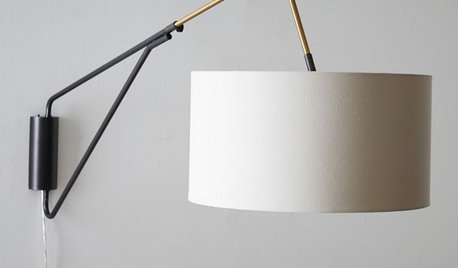Low voltage/Line voltage?
homeschoolmom2
17 years ago
Related Stories

EVENTSTrends from the Front Lines of Furniture Design
See what’s hot in furniture again through the designers’ offerings at the 2014 ICFF
Full Story
COLOR9 Fun Ceiling Colors to Try Right Now
Go bold overhead for a touch of intimacy or a punch of energy
Full Story
HEALTHY HOMEBath Design: Renew Body and Mind With Colorful Light
Take one tired, stressed-out self. Rinse in a shower bathed in blue light (or any color you like). Repeat
Full Story
KITCHEN DESIGN9 Ways to Save on Your Kitchen Remodel
A designer shares key areas where you can economize — and still get the kitchen of your dreams
Full Story
PRODUCT PICKSGuest Picks: Contemporary Lighting for All Kinds of Needs
Task lamps, floor lamps, pendants ... Whether you’re reading in bed or want a glow overhead, there’s a light here for you
Full Story
KITCHEN DESIGNKitchen of the Week: Organic Modernism in Seattle
Craftsmanship from top to bottom gives a linear kitchen overlooking Puget Sound a natural feel
Full Story
LIGHTINGThe Lowdown on High-Efficiency LED Lighting
Learn about LED tapes, ropes, pucks and more to create a flexible and energy-efficient lighting design that looks great
Full Story
DECORATING GUIDESRoom of the Day: A Living Room Designed for Conversation
A calm color scheme and an open seating area create a welcoming space made for daily living and entertaining
Full Story
REMODELING GUIDES5 Hot Tips for Home Saunas
Bask in your very own heated haven, indoors or out. This overview will get you off to a glowing start
Full Story
GARDENING AND LANDSCAPINGA Toronto Rooftop Gets a Luxurious Makeover
Privacy screens, lighting, an outdoor kitchen and safety measures for pets make this spacious rooftop patio comfy for all
Full StoryMore Discussions










Jon1270
hardware_bum
Related Professionals
Florida City Lighting · Green Bay Lighting · South Bend Lighting · Channahon Lighting · Camarillo Furniture & Accessories · Franklin Furniture & Accessories · Madison Furniture & Accessories · Glenvar Heights Furniture & Accessories · Wakefield Furniture & Accessories · Bainbridge Island Decks, Patios & Outdoor Enclosures · Fort Myers Decks, Patios & Outdoor Enclosures · Fort Pierce Decks, Patios & Outdoor Enclosures · Little Rock Decks, Patios & Outdoor Enclosures · San Diego Decks, Patios & Outdoor Enclosures · Urbana Decks, Patios & Outdoor Enclosuresdmlove
dim4fun
homeschoolmom2Original Author
Jon1270
fourwheelin